RedFort
 RedFort Perhaps the most fascinating feast for the tourist's eye is this marvel architecture in the capital.Red Fort could perhaps be singled out as yet another monument which should not escape the tourist's eyes. Known as lal qila (lal means red and qila means fort), it is laid out along the river Yamuna as an irregular octagon. It is surrounded by a wall of about 2.4 Kilometers in circumference and is built of Red Sandstone. The Mughal king Shah Jahan transferred his capital from Agra to Delhi and the fort was completed in 1648, nine years after the king shifted to this city. The fort has two main entrances, the Delhi Gate and the Lahori Gate which faces the famed Chandni Chowk market.
RedFort Perhaps the most fascinating feast for the tourist's eye is this marvel architecture in the capital.Red Fort could perhaps be singled out as yet another monument which should not escape the tourist's eyes. Known as lal qila (lal means red and qila means fort), it is laid out along the river Yamuna as an irregular octagon. It is surrounded by a wall of about 2.4 Kilometers in circumference and is built of Red Sandstone. The Mughal king Shah Jahan transferred his capital from Agra to Delhi and the fort was completed in 1648, nine years after the king shifted to this city. The fort has two main entrances, the Delhi Gate and the Lahori Gate which faces the famed Chandni Chowk market.
Shah Jahan, incidentally was also the king who built the Taj Mahal of Agra. The fort has the Diwan-e-am, where the king would grant audience to the public to listen to their problems. The other feature is the Diwan-e-Khas (khas means special) where the king would grant audience to important people. Besides this, is the Rang Mahal, the water cooled apartment for the royal ladies. In the basement of the fort is a market where several traditional Indian goods can be purchased at nominal rates. Another attraction is the Light and Sound Show held in the evenings.
|
KutubMinar
Another most fascinating feast for the tourist's eye is this magnificent structure in the southern part of the capital. Minar (which means tower) was built by a Muslim King, Qutab-ud-din Albak, as early as 1199 A.D. and a part of it which he could not finish was completed by another Muslim King, IItutmish.
The tower is 72.5 metres high and has at its base a mosque. In front of the imposing structure is an iron pillar believed to have been built in the 5th century A.D. It's uniqueness lies in the fact that it has not caught rust ever since it was built. Tourists are not permitted to climb the tower.
|
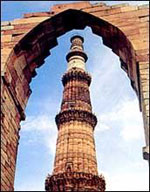 |
LotusTemple
 |
Is a very recent architectural marvel of the Bahai faith and is visible from several spots in south Delhi. Located in Kalkaji in the south of Delhi, it is lotus shaped and has rightly been given the name. It is made of marble, cement, dolomite and sand. It is open to all faiths and is an ideal place for meditation and obtaining peace and tranquility.
|
|
JamaMasjid
Is the country's largest mosque where thousands of Muslims offer prayers even today. It was built in 1656 and is a tribute to the values of the Mughal Kings as also their commitment to religion and prayer. It lies opposite the Red Fort and is surrounded b a large number of shops which deal in a variety of goods.
The flight of stairs and its large courtyard are something to be admired. Besides this there is a variety of the choicest non-vegetarian food available in several restaurants located around the complex.
|
 |
JantarMantar
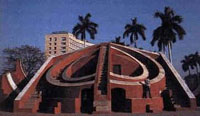 |
Within the Connaught Place area is the Jantar Mantar observatory built by the Rajput king of Jaipur, Sawai Jai Singh in 1724. It was believed to have been built with masonry instruments for observing the movements of the stars and the planets. The samrat of the mantra supreme instrument, the largest structure in the complex which is in the shape of a right-angled triangle, is actually a huge sun-dial.
|
Purana Qila (Old Fort):
The ruins of the fort are located on a small hill which once stood on the banks of the river Yamuna. Legend has it that the fort marked the site of Indraprastha, the magnificent capital of the Pandavas, though the construction was carried out by Sher Shah Suri any time between 1538 to 1545 A.D. The structure houses a mosque which has a double-storeyed octagonal tower. It is said that the Mughal king Humayun fell from the tower accidentally and died. At the foot of the hill is a lake where the Delhi Tourism has arrangements for boating.
|
|
Humayun's Tomb
Is the country's largest mosque where thousands of Muslims offer prayers even today. It was built in 1656 and is a tribute to the values of the Mughal Kings as also their commitment to religion and prayer. It lies opposite the Red Fort and is surrounded b a large number of shops which deal in a variety of goods.
The flight of stairs and its large courtyard are something to be admired. Besides this there is a variety of the choicest non-vegetarian food available in several restaurants located around the complex.
|
 |
Safdarjang's Tomb
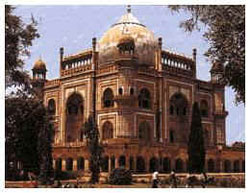 |
The garden tomb was built in 1753-54 soon after Safdarjang died. It is a red and brown sandstone with double storeyed towers in the corners and is one of the last examples of Mughal architecture.
|
Lodi's Tomb:
The tombs are in the midst of the famed Lodi Gardens and is believed to have been built by rulers of two dynasties, the Sayyaids and the Lodis. History has it that the tombs are remnants of another city that was sought to be built in Delhi.
Chandani Chowk:
Chandni Chowk: It was the eyes and ears of the Mughal's commercial instincts and is today one of the country's best known wholesale markets for textiles, electronic goods and watches. The entire area was designed by Jahanara Begum, Shah Jahan's favourite daughter and was then inhabited by the well-to-do families oft he time. There is however a word of caution and that is that there are several elements who are believed to be selling duplicate goods and the tourist needs to be careful about this.
Charity Bird's Hospital:
Just before one enters the Chandni Chowk area one cannot miss seeing the charity bird's hospital located within the precincts of a temple. Bird lovers bring their pets here for treatment free of cost. So if one of your pets is in trouble then this is the place you need to go to.
Delhi may be an ancient city, but besides the old monuments mainly of the famed Mughal era, the city has a lot to write home about its modernity and the marks that it has left on the capital. And some of the comparatively recent structures are as much worth visiting as are the ancient lot.
|
|
Parliament House
A marvellous piece of architecture which can be admired only from outside on account of security restrictions. Close to Rashtrapathi Bhavan, it is a domed almost circular structure almost a kilometer in circumference, and was designed by the famed architect Lutyens. It is the seat of the Indian Parliament and during the sessions of Parliament there is a flurry of activity in and around the structure.
|
 |
Rashtrapati Bhavan
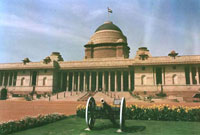 |
Almost a stones' throw away from Parliament House is the Rashtrapati Bhavan which is the official residence of the President of the country. Designed by Lutyens, it was the official residence of the Viceroy when the British ruled India. With 340 rooms and an area of about 330 acres. It is an imposing structure anda tourist's delight. The pillars and the porticos are an architect's marvel and so are the Durbar Hall and the Ashoka Hall within the complex. Although special permission has to be obtained to visit the complex, the Mughal Gardens within the complex are a treat for the eyes and are open to the public during certain periods of the year.
|
|
India Gate
Straight down the road from Rashtrapati Bhavan along a magnificent view and totally unhampered drive is India Gate which is primarily a memorial to the unknown soldier. Designed by Lutyens, the 42 metre high structure is a war memorial in honour of the soldiers who died during the second world war. The imposing structure from where stretch massive lush green lawns has an eternal flame (amar jawan jyoti) to honour the memory of the unknown soldiers. A popular picnic spot, one can see hoards of people moving about the area and on the lawns on summer evenings.
|
 |
Connaught Place:
One of Delhi's most popular shopping centres built as early as 1931 there is nothing that one cannot buy here and it also has several eating houses which are for a large part of the day dull. The state emporia buildings are also located in this area so are the head offices of major banks, airlines and other such things of importance to the tourist. The complex, popularly referred to as C.P. is an important meeting point for all sections of people and is something which no tourist should miss if for nothing else then for its architecture and the humdrum of everyday life.
National Gallery of Modern Art:
Located very close to India Gate, the building was the palace of the Maharaja of Jaipur. It has around 4,000 paintings of modern artists and also included are graphics and sculptures. The gallery arranges special exhibitions for those who wish to exhibit their works. The gallery also houses a library which can be used by museum, which is open from 1000 hours to 1700 hours, is closed on all holidays and observes Monday as its weekly off.
National Museum:
The National Museum is another interesting spot located very close to India Gate. The museum has a rich variety of all facets of ancient Indian history and alsoof central Asia. In fact the museum takes one through a fascinating journey of what ancient India was all about, rare coins, pottery, and numerous such things including art and architecture, costumes are for all to see. It's something every tourist should find time to visit even if the schedule is tight.
National Zoological Park:
The Delhi zoo, close to Purana Qila, near ITO, was established in 1959 and is spread over a massive area of 214 acres. Is is regarded as one of the finest zoos in Asia and efforts have been made to provide an almost natural habitat to the animals and birds. There are more than 2,000 animals and bird species from places like Africa, America, Australia and even Asia. There is a lot of greenery around the zoo and it is an ideal picnic spot especially in winter. Timings summer 0800 to 1800 hours, winter 0900 to 1700 hours. Closed on Friday.
Pragati Maidan:
The venue of the annual India International Trade Fair where thousands of businessmen and visitors come from all over the world in November. It is a massive complex with well laid out roads and close to the zoo as ITO. The complex also hosts all the international trade fairs. It also has permanent buildings for pavillions of all the states of the country. It is ideal to visit in the winter months. Timings Weekdays: 0930 to 1730 hours; Sundays and public holidays: 0930 to 2000 hours.
Birla Mandir:
is another landmark close to Connaught Place and was built by industrialist Raja Baldev Birla in 1938. The temple is an important prayer site and contains idols of several deities. Interestingly Mahatma Gandhi, who inaugurated the temple, was also a regular visitor to it and would often pray there.
|
|
Rail Transport Museum
Located in the south of Delhi close to the diplomatic area of Chanakayapuri it traces, through exhibits, the 140 year-old history of the Indian Railways. The museum, established in 1977, and spread over a ten acre area, is the first of its kind in India. The highlights include the Fairie Queen of 1885 the oldest working steam locomotive, the luxury saloon of the Prince of Whales and the saloon of the Maharaja of Mysore. Timings Summer 0830 to 1130 and 1600 to 1730 hours, Winter: 0900 to 1730 hours. It is closed on mondays.
|
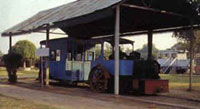 |
Aurobindo Ashram:
Again in the south of Delhi near the Indian Institute of Technology on the road to Meharauli it has literature on the life of Sri Aurobindo and the Mother and has an ashram where devotees can come to meditate. There is also some accommodation available for devotees of Sri Aurobindo.
Teen Murti Bhavan:
It was the official residence of Jawaharlal Nehru when he was the Prime Minister and after his death it was converted into a museum. Through pictures and other literature, the various facets of the life of Pandit Nehru have been shown.
|
|